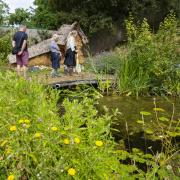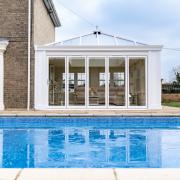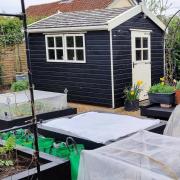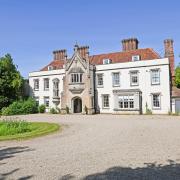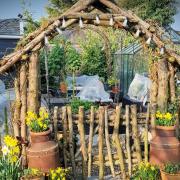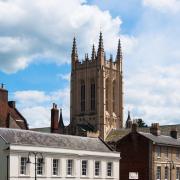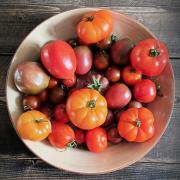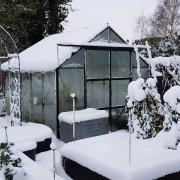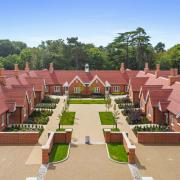Suffolk blossoms at this year's RHS Chelsea Flower Show as Frederic Whyte, award-winning garden designer teams up with young landscaper Louis Champain and Brampton Willows to create a garden celebrating the charity Fine Cell Work
Frederic Whyte arrives at our meeting somewhat breathlessly in between his garden design projects – a couple in Aldeburgh, two in Walberswick, “a huge one” in Dunwich and a few more. But today we’re here in Halesworth with landscaper Louis Champain to talk about their Sanctuary show garden at this year’s RHS Chelsea Flower Show.
The Stitchers’ Garden is a celebration of the 25th anniversary of Fine Cell Work, a charity that teaches prisoners skilled craftwork to boost their wellbeing, to give them hope, and to help them to rehabilitate on their release. The theme is Regrowth. There has rarely been a Chelsea show garden with such strong Suffolk connections. Saxmundham-based Gold medallist Frederic is collaborating with Louis and his team at Champain Landscapes and Brampton Willows, and a version of the garden will be located at a Suffolk prison after the show.



As for the intricate work of putting the The Stitchers’ Garden together, I happen to mention some RHS blurb about wild plants and naturalistic designs taking centre stage this year. That sets Frederic off good and proper about the trend of people being sold misleading notions of wildflower planting. “The garden is not meant to be a thoughtless imitation of nature, Marion. It’s about working with nature, so for me a garden needs structure. It needs human intervention and artistry.” In recent years he’s been listening to people as they stroll around the showground and reckons they heave a sigh of relief when they see an 'actual garden', rather than the much-hyped natural planting.
“I think Louis would agree with me that our garden is going to stand out because it really is a garden. Don’t get me wrong, I love naturalistic planting and the new perennial movement but there needs to be some good structure there.” Louis is nodding in agreement. Plainly, both are on the same page and it’s fair to say The Stitchers’ Garden, with its pavilions of highly-crafted willow work, clay paviours by sponsor Vande Moortel and colourful planting, is a clear example of the artistry for which these two are known. Leading design houses Nina Campbell and William Yeoward are also sponsoring the garden and both are collaborating with Cath Kidston, a trustee of Fine Cell Work, to create a series of products inspired by the garden and the theme of regrowth.


Visitors will see into the garden through a ‘cell’, a simple steel structure with woven willow panels that replicate the dimensions of their prison space. Opposite, a larger pavilion with more open woven willow panels echoes the form of the cell - a metaphor for the space in which the creative exchange between prisoners, designers and Fine Cell Work takes place.
Between the pavilions is a transparent pool with three fountain jets to evoke the dynamism and clarity of the creative process that prisoners go through. The bright flowers represent the creativity and colour that needlework brings into prisoners’ lives in over 30 prisons across Britain. The garden is designed on the basis of Frederic’s chosen conditions of full sun and rich, damp soil, allowing beautiful and blousy lupins, peonies and irises to flourish.
“The willow is all about rejuvenation,” says Frederic. “Cut it right down and it grows again and that seems to tie in with prisoners trying to rejuvenate their lives. You weave willow and you weave when you embroider.” He explains how willows are naturalistic and organic yet, when sculpted, they can be used in a contemporary way which is how he has used the garden’s feature trees - a variety of multi-stemmed scarlet willow called Salix alba ‘Chermesina’. The pavilion panels, donated by Brampton Willows, “look quite wavy and naturalistic”, says Louis, warming to the theme, “but at the same time more structured which is a departure from the notion of willow as a dying art”.



“Natural doesn’t necessarily have to be informal”, says Frederic, fervently. “A gardenesque garden can be sustainable. It doesn’t have to look like a marsh or a woodland to be sustainable. People are sold these notions but if you plant in more traditional blocks, people know where things are and know what they’re doing. I don’t know where people get this into their heads that you’ve got to have a wavy lawn to be naturalistic. I’m on my soapbox again,” he laughs.
But he deserves that soapbox. Over the years, clients from Westminster to Walberswick and from South Africa to Southwold, have given ringing endorsements of his skills. “Wonderful eye for scale and colour,” said one. “An exceptional plantsman and designer,” said another. And yet another: “A nostalgic planting scheme that evokes my Suffolk childhood.”

Frederic’s own childhood was in Lowestoft where he started gardening as a boy with his grandfather. Today he is renowned for his formal and elegant designs yet gardens were not his first career. Leaving home for university in his twenties to study English literature, he went on to study 18th century British women travellers for his PHD. He later gained a Diploma in Garden Design from the English Gardening School and got his first commissions in Italy. “But there wasn’t a lot of scope for me in Italy because, when people want a garden done, they’ll phone the local nursery who will come in with a truckload of olive trees, rosemary and lavender.”
Even so, he gained some prestigious commissions, including for the Oscar-winning actor Colin Firth’s garden in Umbria. He returned to London 2011 to work across the UK and won a Gold with his second Chelsea garden. Then, four years’ later, he was back in Suffolk. He experiments with colour in his small walled garden in Saxmundham – “last year quite racy yellow and burgundy, this year green and white with pale pink but with slug-resistant plants”, he laughs. The town is convenient for Aldeburgh and the coastal areas where many of his clients have homes.

“I aim to bring together the space and the client. My creative task is to make sure that both are happy. One has to think carefully about the conditions but also what the client wants. Having said that, I’m a great fan of hydrangeas, roses, irises, crab apples – you know, garden plants. And amelanchiers of course which are designers’ favourites as one can sculpt them.”
Teaching and academic research in the humanities, has provided him with a rich store of inspirational ideas and his knowledge of garden history has enabled him to enhance his portfolio with projects such as the rejuvenation of an Italianate garden in Suffolk and an extensive Arts and Crafts style garden in Walberswick. Fine Cell Work is not the first charity Frederic has supported by donating his considerable garden design skills. Among the half-dozen show gardens for charity are the Bounce Back Foundation to retrain ex-offenders and the St Elizabeth Hospice garden.
For Louis, participating at Chelsea will be a first. Formerly a product designer, he has made impressive strides since he started Champain Landscapes in 2013 and now has 20 full-time staff with varying skills and expertise. Frederic and Louis now have a good portfolio of projects in Aldeburgh, Southwold, Walberswick and Dunwich, but they are both looking forward to relocating a version of The Stitchers’ Garden to Suffolk that will be easy for prison residents to maintain in the longer term. “A really nice legacy to contribute to,” says Louis.
fredericwhyte.com
champainlandscapes.com
Suffolk at RHS Chelsea
If you're heading to this year’s RHS Chelsea Flower Show, May 24-28, The Stitchers’ Garden by Frederic Whyte, commissioned by the charity Fine Cell Work, is not the only one to look out for that features a Suffolk-based designer. He will be joined in the Sanctuary Gardens by The Boodles Travel Garden designed by Tom Hoblyn in partnership with luxury jeweller Boodles.
More information at rhs.org.uk/shows-events/rhs-chelsea-flower-show/Gardens






